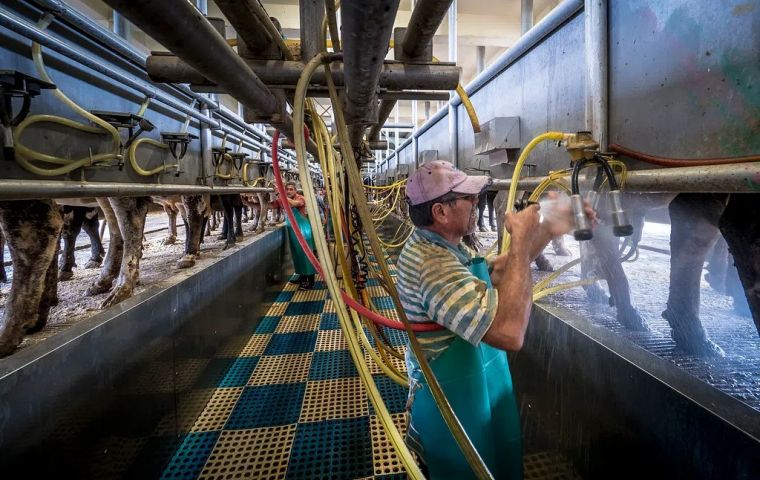MercoPress. South Atlantic News Agency
US CDC calls for more testing of dairy workers given the spread of avian flu
 Blood tests for 115 farmworkers in Michigan and Colorado showed eight workers — or 7% — had antibodies indicating previous infection with Type A H5N1 virus
Blood tests for 115 farmworkers in Michigan and Colorado showed eight workers — or 7% — had antibodies indicating previous infection with Type A H5N1 virus United States health officials have called for more testing of employees on farms with bird flu after a new study showed that some dairy workers had signs of infection, even when they didn’t report feeling sick.
Farmworkers in close contact with infected animals should be tested and offered treatment even if they show no symptoms, said Nirav Shah, principal director of the U.S. Centers for Disease Control and Prevention.
The new guidance comes after blood tests for 115 farmworkers in Michigan and Colorado showed eight workers — or 7% — had antibodies that indicated previous infection with the virus known as Type A H5N1 influenza.
“The purpose of these actions is to keep workers safe, to limit the transmission of H5 to humans and to reduce the possibility of the virus changing,” Shah said.
The U.S. Centers for Disease Control and Prevention study provides the largest window to date into how the bird virus first detected in March in dairy cows may be spreading to people. It suggests that the virus has infected more humans than the 46 farmworkers identified in the United States. Nearly all were in contact with infected dairy cows or infected poultry. Outside experts said it’s notable that the study prompted the U.S. Centers for Disease Control and Prevention to take new action. Previous recommendations called for testing and treating workers only when they had symptoms.
Gregory Gray, an infectious disease researcher at the University of Texas Medical Branch in Galveston, said, “This is a significant move towards the assessment that these H5N1 viruses are a greater risk than the CDC estimated before.”
Angela Rasmussen, a virus expert at the University of Saskatchewan in Canada, said, every additional infection in animals or humans gives the virus a chance to change in potentially dangerous ways.
“It shows yet again that we are not responding effectively to the H5N1 cattle outbreak in humans or animals, and if we continue to let this virus spread and jump from species to species, our luck will eventually run out,” Rasmussen said in an email.
The CDC study included 45 workers in Michigan and 70 in Colorado tested between June and August. Of the eight workers with positive blood tests, four reported no symptoms. All eight cleaned milking parlors and none used respiratory protection such as face masks. Three said they used eye protection.
The virus has been confirmed in at least 446 cattle herds in 15 states. Recently the Agriculture Department said a pig at an Oregon farm was confirmed to have bird flu, the first time the virus was detected in U.S. swine




Top Comments
Disclaimer & comment rulesCommenting for this story is now closed.
If you have a Facebook account, become a fan and comment on our Facebook Page!